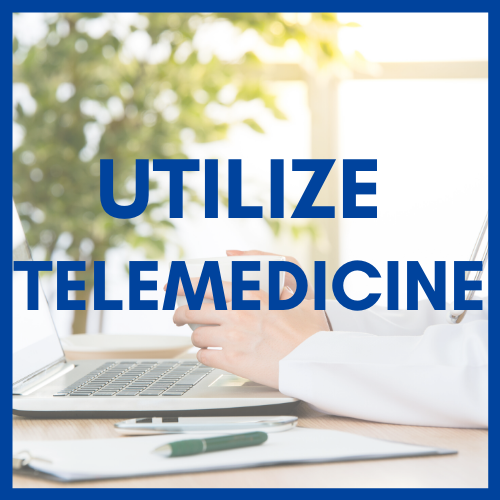
Your clinic has likely already shifted to using telemedicine, virtual check-ins, remote patient monitoring, and eVisits. The Centers for Medicare and Medicaid Services (CMS) and private payers have updated their regulations during the pandemic so visits are more feasible for both clinicians and patients.
Answers to Your Questions about Telemedicine
How do I get started? Click the link for answers to the questions below.
- How do I start setting up telemedicine?
- What platform do I use?
- Do I need to have the patient sign a telemedicine consent form?
- What do I do if the patient is not able to connect? Can I still have an encounter?
How do I conduct a physical exam via Telemedicine? Click the link for a video that answers this question. ![]() A transcript is available here.
A transcript is available here.
How do I conduct a professional Telemedicine visit? Click the link for a video that answers this question. ![]() A transcript is available here.
A transcript is available here.
How can I use Telemedicine with my patients who have asthma? Click the link for a video that answers this question. A transcript is available here.
How does billing work? Click the link for answers to the questions below.
- How do I bill for a telemedicine visit?
- How do I bill for Medicare patients?
- How do I bill for Medicaid patients?
- How do I bill an e-visit?
- Can I bill for telephone encounters?
Telemedicine Lessons Learned During the COVID-19 Pandemic: A video from the Joint Task Force on Technology and Telemedicine. A transcript is available here.
Helpful Toolkits
CMS Telehealth Toolkit for General Practitioners
Updated CMS Medicare fee-for-service FAQs. Telehealth guidance begins on page 35 and includes additional guidance related to telephone-only codes (Q24), billing of disconnected telehealth visits (Q25) and consent requirements for certain telehealth and other virtual visits (Q32).
Regulatory Updates
Medicare Telehealth
Effective March 6, 2020, Medicare will pay for office, hospital, and other visits furnished via telehealth across the country and regardless of the patients location (e.g., home). CMS recently reminded practitioners that they can update their enrollment with their home location, in order to deliver telehealth from their home. Additional information regarding HHS’ enforcement discretion on HIPAA privacy and security is below.
Virtual Check-ins & eVisits
Where an established relationship is present, practitioners offer virtual check-ins and eVisits. Virtual check-ins can be delivered with a broader range of communication methods, such as telephone, audio/video, secure text messaging, email, or use of a patient portal, with the patients consent. Patients can also request an eVisit through a patient portal. Information about coding for various services can be found here: Utilize Telemedicine: How does billing work?
Acceptable Technologies
During the COVID-19 national emergency, certain provisions of HIPAA will not be enforced for covered health care providers utilizing telehealth services. This allows clinicians some flexibility to utilize technologies that may not be fully compliant with HIPAA rules. For example, a clinician may use the private video chat functions in common apps, such as Facebook Messenger, Zoom, or Google Hangouts. However, public-facing apps (e.g., Facebook Live, TikTok) are not allowed. Read the full notification of enforcement discretion here.
In addition, the telephone may be used as long as the telephone has "audio and video capabilities that are used for two way, real time interactive communication.” The act does not restrict telehealth to the diagnosis related to the Coronavirus but it does restrict telehealth to services previously covered for telehealth (consultations and office visits). The full list of telehealth services is on CMS’ website.
State Licensing
While Secretary Azar was able to waive certain licensure requirements to allow for Medicare and Medicaid payments to providers who do not have a license within that State, the waiver does not extend to non-Federal programs. As such, some states require physicians to have a medical license in the same state that their patient is located in order to provide virtual healthcare.
Given this long-standing challenge, the Federation of State Medical Board (FSMB) established the Interstate Medical License Compact Commission (IMLCC) to help clinicians practice across state lines. At this time, 29 states, the District of Columbia and the Territory of Guam, have agreed to the compact. Note that twelve (12) state boards issue a special purpose license, telemedicine license or certificate, or license to practice medicine across state lines to allow for the practice of telemedicine.
Credentialing
Even if an out-of-state provider is able to address the licensure and credentialing issues, the practitioner may be considered out-of-network by private payers.
Additional Resources from the AAAAI
A recording of the JACI: In Practice Virtual Journal Club discussing COVID-19: Unmasking Telemedicine, is now available.
A recording of the Telemedicine Strategies for COVID-19 and Beyond webinar, part of the 2020 Virtual Practice Management Workshop, is now available.
Help patients prepare for a telemedicine visit:
10 Tips to Help You Master Your Telemedicine Visit: A Patient Guide
10 consejos para ayudarlo a tener una excelente visita de telemedicina: Guía para el paciente
Additional Resources From External Groups
Navigate your State’s Response to COVID-19
Track and compare every state's bills in response to the coronavirus. This resource is available to everyone who needs to better understand. It includes legislation, ranging from health preparedness, to worker compensation and economic injury relief for small businesses to Executive Orders. It is searchable by state and by topic.
Centers for Medicare and Medicaid Services (CMS) Public Health Emergencies

 Facebook
Facebook X
X LinkedIn
LinkedIn Forward
Forward